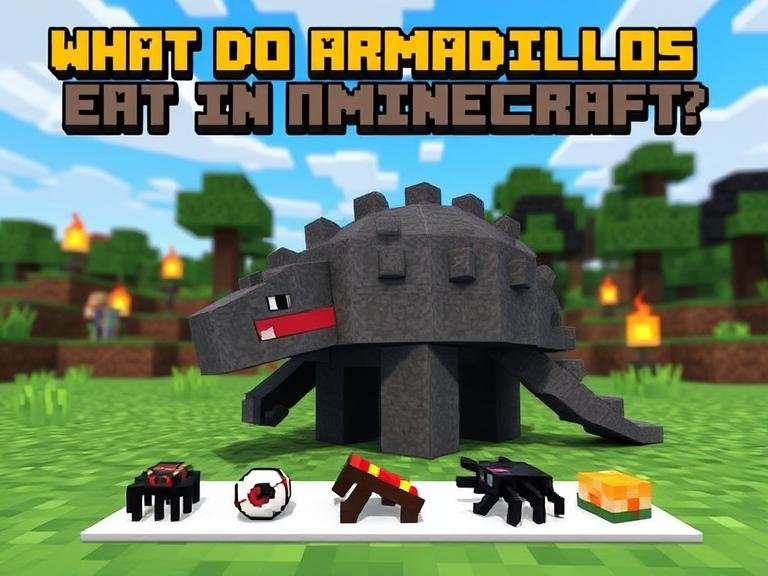With the 1.20.5 update, Minecraft introduced an intriguing new mob: the Armadillo. These small, passive creatures bring a unique charm to savanna and badlands biomes, and add interesting gameplay dynamics. One of the most curious aspects players notice is: what do armadillos eat in Minecraft? This guide dives deep into their diet, behavior, uses, and more—without borrowing from existing content.
Table of Contents
1. Armadillos: A Brief Introduction
Armadillos are peaceful mobs native to warm biomes, especially savanna and badlands regions. They spawn in small groups—often two in savannas and one to two in badlands—purely as ambient wildlife that enhances biome variety.
These creatures are more than decoration; they can roll into a defensive cube when startled, particularly if you sprint near them, attack them, or if undead mobs are nearby. While curled up, they’re much harder to harm, although they do occasionally peek out when danger passes.
2. So, What Do They Eat?
Despite their gentle appearance, armadillos have a surprising diet: they eat Spider Eyes. This peculiar choice brings an unexpected twist to gameplay, since Spider Eyes are typically ingredients for brewing.
Feeding a Spider Eye to two adult armadillos triggers breeding, producing a baby armadillo. Additionally, providing a Spider Eye to a baby armadillo accelerates its growth—each eye speeds growth by 10%.
This mechanic cleverly ties into real-life armadillo behavior, as they consume insects such as spiders, though obviously the game adds a comedic twist by having them nibble on a spider’s eye.
3. Feeding Mechanics in Game
Here’s how feeding armadillos works:
- Obtain Spider Eyes
Dropped by spiders and cave spiders—usually found at night or in dark caves. - Find Armadillos
Search savanna and badlands biomes, preferably under tall grass or roaming freely in open areas. - Feed the Armadillos
Hold a Spider Eye and interact with an armadillo. For adults, this activates breeding if both are fed. For juveniles, it speeds up growth.
Unlike taming, this does not domesticate them—it’s merely food-based interaction.
4. Why Spider Eyes?
This choice of diet is surprisingly clever:
- Adds value to a rarely-used item: Spider Eyes are mainly potion ingredients, but now they also have utility in interacting with mobs.
- Reflects real-world ecology: Real-world armadillos eat insects (like spiders), so the in-game behavior aligns loosely with their real-life biology.
5. Benefits of Interaction
Feeding armadillos has multiple advantages:
- Breeding: Acquire more armadillos, which helps if you want more scutes or just enjoy their presence.
- Growth Acceleration: Fast-track baby armadillos to adulthood using Spider Eyes.
- Scute Harvesting: Adult armadillos drop Armadillo Scutes naturally every few minutes, or more immediately if you brush them—though this isn’t feeding-related, it complements the utility of breeding.
6. What If You Don’t Feed Theme
So while feeding enhances interaction, armadillo mobs still serve a purpose without direct player involvement.
7. Summary Table
| Aspect | Details |
|---|---|
| Diet | Spider Eyes (both breeding and growth acceleration) |
| Spawn Biomes | Savanna and Badlands biomes predominantly |
| Defensive Trait | Rolls into cube when threatened |
| Scute Production | Drops scutes passively or via brushing; for wolf armor crafting |
| Utility | Adds ecological richness, resource gathering, breeding system |
8. Developer Notes & Community Thoughts
Design-wise, giving armadillos a diet of Spider Eyes is both whimsical and functional—it’s a memorable mechanic that adds flavor to mob interaction.
Community reactions echo this sentiment. One Reddit user noted:
“It make sense that Armadillos can eat Spider eyes because they also eat spiders in real life…”.
Players appreciate the blend of Roblox-like charm and subtle functionality.
Frequently Asked Questions (FAQs)
Q1: What happens when you feed a baby armadillo?
A1: Each Spider Eye speeds growth by 10%, helping the baby armadillo reach adulthood faster.
Q2: Can armadillos be tamed?
A2: No. Feeding does not tame armadillos; they remain neutral and roam freely.
Q3: Do armadillos eat anything besides Spider Eyes?
A3: No. In Minecraft, Spider Eyes are the only accepted food for armadillos, though this is a creative twist on their real-world diet.
Q4: Why Spider Eyes?
A4: This design choice gives more value to a rarely used item and ties into the insect-eating nature of armadillos.
Q5: Where do armadillos spawn?
A5: They spawn in savanna biomes (especially savanna plateaus, windswept savanna) and badlands variants.
Conclusion
In Minecraft, armadillos eat Spider Eyes—a quirky and unexpected choice that elevates gameplay by providing a breeding mechanic, aligning with real-world behavior, and increasing the utility of a typically overlooked item. These creatures enrich warm biomes and offer practical value through scute collection and breeding—without needing taming or elaborate systems.
Exploring savannas with Spider Eyes in hand now adds meaningful interaction and resource management, making Minecraft’s ecosystem just a bit wilder—and far more delightful.

